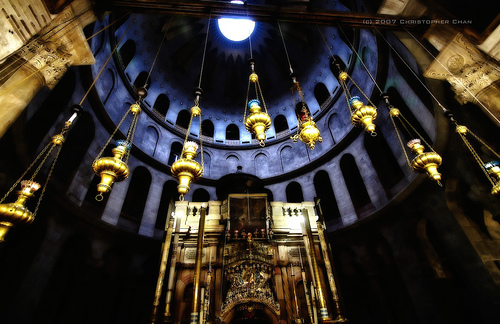
A few weeks ago on Saturday when everything was shut down because of Shabbat—the bus lines quiet, the streets full of dust rather than people, a stray cat or two roaming the alleyways—I decided to walk to the Mount of Olives, itching to explore more of the city.
Dripping with sweat by the time I arrived, after an hour-long walk in near 100-degree heat, I watched groups of tourists milling about, faces bright red, some trying to cool down by fanning themselves to no avail. Entering the Gardens of Gethsemane and the Church of All Nations on the Mount of Olives, I overheard a tour guide explain to a large group the importance of the church and the gardens. He went on and elaborated by noting that even though this site was important to Catholics for one reason, it was important to the Greek Orthodox community for another. It struck me then how many different versions of one story and one history there were. One group saw things one way, and a different group saw things another. In Jerusalem, where neighborhoods were usually (but not always) either Jewish or Arab, where there were four distinct quarters in the Old City, where a ladder has not moved in the Church of the Holy Sepulchre for something around 300 years because it would create too much conflict between different Christian groups, all those different ways of seeing seemed to create more tension than not.

After that, I was convinced that I would get more out of the day if I took a tour, so I found a tour guide. Starting right away, he told me about the olive trees that were two thousand years old, and the myriad holy sites that dotted the Mount of Olives. Deciding there were other places I wanted to see, we went to drive through the city.
As we wound through traffic jammed streets, and my tour guide explained what we were seeing out the window—a church, a town, a settlement, crops of desert palm trees, I was less interested in probably the twentieth church we had seen, and more interested in the ramblings of both the taxi driver and my tour guide. Both were Palestinian. They complained about their wives, laughed over their children, and discussed how slow business had been in the past few days.
“That was my wife on the phone. She won’t stop nagging me! Bah.”
“It’s been a rough week. My son had to go to the hospital after a bad fall. He’s still there.”
“This traffic is terrible. This always happens during wedding season.”
As we drove, we passed a herd of goats grazing under a bridge, children playing soccer in a dirt field, and houses that were partly destroyed. We saw a white horse ambling up a street that was busy with cars. As we went through part of the desert, we passed a few Bedouin villages; the structure of their homes built with dirty cloth, split pieces of wood and ripped tarps. According to my tour guide, they weren’t supposed to be there.
As we made our way back to the Mount of Olives again, after having seen more churches and many more historical sites, my tour guide asked me what I thought about the “wall.”
“What? The Western Wall in the Old City?”
“No, the separation wall in Jerusalem.”
Being in no way an expert on the matter, I mumbled some answer back, words coming out of my mouth but not really conveying anything of significance. He went on to tell me how difficult it was to get through the wall’s checkpoints which made it hard to get to work, saying how he sometimes felt as if there was a cage around him.
“Are there problems where you live in America?”
“Well, I suppose there are problems everywhere—”
“But at least you’re free,” he said, laughing a bit. “At least you can go where you want.”
Jerelyn Luther ’16 is blogging this summer from Jerusalem, Israel.